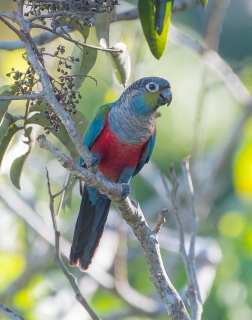Crimson-bellied Conure |
|
|
Also known as: Crimson-bellied Parakeet
Photos
View in GalleryDid You Know?
The Crimson-bellied Conure engages in geophagy (eating of soil) at clay licks.Academic Research
Related publications: Pyrrhura perlataSpecies Profile
Genus: Pyrrhura | Species: perlata
Size:
24cm (9.3 in)
Weight:
85-94g (3-3.3 oz)
Subspecies including nominate:
one
Colour Adult:
Both adults partly green in colour; brown breast with pale off-white and dark brown barring; yellow/green cheeks, turning to blue on lower cheeks; blue collar around hindneck which varies with each bird; red bend of wing, lesser underwing coverts and abdomen; blue thighs to tail coverts; brown/red tail. Bill brown/grey. Eye ring bare and white. Eye dark brown.
Colour Juvenile:
Green lower breast and abdomen. Bill horn in colour with pale grey at base.
Call:
Calls made in flight are shrill.
Listen NowVideo Links:
Video 1More Information:
Content Sources:
CITES
BirdLife International
Cornell Lab of Ornithology/Birds of the World
Parrots: A Guide to Parrots of the World, Juniper and Parr, 1998
ML Media Collection Catalogue 88875, Crimson-bellied Parakeet Pyrrhura perlata, Marantz, Curtis, Mato Grosso, Brazil, Nov. 12 1997, Cornell Lab of Ornithology. Site
Parrots of the World, Forshaw and Cooper, 1989. 2010 edition
Parrots of the World, Forshaw, 2006.
Parrots in Aviculture, Low, 1992.
Lexicon of Parrots, Thomas Arndt.
Photos
View in GalleryDid You Know?
The Crimson-bellied Conure engages in geophagy (eating of soil) at clay licks.Academic Research
Related publications: Pyrrhura perlataSpecies Care
Captive Status:
Rare
Longevity:
Probably about 12-15 yrs.
Housing:
Aviary or suspended enclosure minimum length 2m (6.5 ft).
Diet:
Fruits such as: apple, pears, oranges, bananas, pomegranate, cactus fruits, forming about 30 percent of the diet; vegetables such as: carrots, celery, green beans, peas in the pod; fresh corn, green leaves such as: Swiss chard, lettuce, dandelion, chickweed, sowthistle; spray millet; seed mix such as: canary, millet and smaller amounts of buckwheat, oats, safflower and a little hemp; limited soaked and sprouted sunflower; cooked beans and pulses, boiled maize, and complete pellet.
Enrichment:
Are avid chewers so provide plenty of bird-safe, unsprayed flowering, fir, willow, pine, elder or saskatoon branches, wooden block toys, vegetable tanned leather toys. Provide ladders, swings, ropes; noise-makers, push and pull toys, foraging/puzzle toys. Also enjoys bathing so provide overhead misters or shallow water bowls.
Nest Box Size:
Vertical box 20cm x 20cm x 70cm (8 x 8 x 30 in).
Clutch Size:
4-6
Incubation Time:
24-25 days
Fledging Age:
7-8 weeks
Hatch Weight:
Not recorded.
Peak Weight:
Not recorded.
Weaning Weight:
Not recorded.
Photos
View in GalleryDid You Know?
The Crimson-bellied Conure engages in geophagy (eating of soil) at clay licks.Academic Research
Related publications: Pyrrhura perlataSpecies Wild Status
World Population:
Unknown, decreasing.
IUCN Red List Status:
Least Concern
CITES Listing:
Appendix II
Threat Summary:
Models of future deforestation predict a 20-30% loss of habitat in this species' range. It is also susceptible to hunting. There is concern it will undergo a noticeable decline (about 30%) in the course of the next three generations.
Range:
Amazon River basin in N Brazil and NE Bolivia.
Habitat:
Found up to 600m (1968 ft) in lowland terre firme tropical rainforest, forest edge, clearings and secondary growth forest.
Wild Diet:
Feeds on Cecropia catkins, Ficus figs, flowers of Bertholletia excelsa and Dioclea glabra, and fruits of Trema micrantha, Eugenia, Zanthoxylum, Tetragastris altissima, Goupia glabra, Alchornea discolor and others.
Ecology and Behaviour:
Seen in small flocks and occasionally in mixed groups with Painted Conures (Pyrrhura picta) and Golden-winged Parakeets (Brotogeris chrysopterus). Often seen descending to rivers and creeks to bathe and drink.
Clutch and Egg Size:
4-6 eggs, 25 x 20mm (1.0 x 0.8 in).
Breeding Season:
August-November; probably also April-June. Presumably nests in tree hollows.
Related Links:
Photos
View in GalleryDid You Know?
The Crimson-bellied Conure engages in geophagy (eating of soil) at clay licks.Academic Research
Related publications: Pyrrhura perlataMembers Only Resources
Please log-in now to find more research, resources and tools.
Not a Member?
Find more great information:
Gain exclusive access to 600+ pages of additional research, seminars and podcasts, specialists to ask your toughest questions, and dozens of other fun resources - when you become a WPT member.
Join Today >>

































